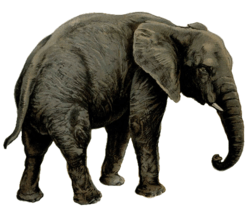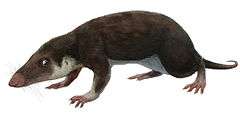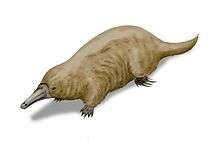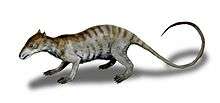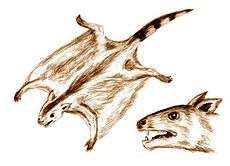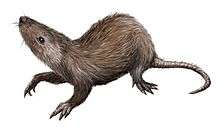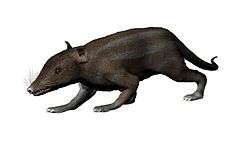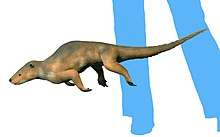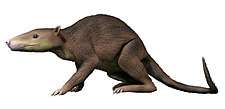Afrotheria
Afrotheria (from Latin Afro- "of Africa" + theria "wild beast") is a clade of mammals, the living members of which belong to groups that are either currently living in Africa or of African origin: golden moles, elephant shrews (also known as sengis), tenrecs, aardvarks, hyraxes, elephants, sea cows, and several extinct clades. Most groups of afrotheres share little or no superficial resemblance, and their similarities have only become known in recent times because of genetics and molecular studies. Many afrothere groups are found mostly or exclusively in Africa, reflecting the fact that Africa was an island continent from the early Cenozoic until around 25 million years ago, when the Tethys Sea shrank.
| Afrotheria | |
|---|---|
 | |
| 1. Aardvark 2. Dugong 3. Black and rufous elephant shrew 4. West Indian manatee 5. Golden mole 6. Rock hyrax 7. African bush elephant 8. Tailless tenrec | |
| Scientific classification | |
| Kingdom: | Animalia |
| Phylum: | Chordata |
| Class: | Mammalia |
| Infraclass: | Placentalia |
| Superorder: | Afrotheria Stanhope et al., 1998 |
| Orders | |
|
See below | |
Because Africa was isolated by water, Laurasian groups of mammals such as insectivores, rodents, lagomorphs, carnivorans and ungulates could not reach Africa for much of the early to mid-Cenozoic. Instead, the niches occupied by those groups on the northern continents were filled by various groups of afrotheres via the process of convergent evolution. The small insectivorous afrotheres such as elephant shrews, golden moles, and tenrecs filled the niches of insectivores, the hyraxes filled the roles of rodents and lagomorphs, the aardvarks filled the roles of various medium size ant-eating mammals (anteaters, armadillos, pangolins, echidnas, numbats, etc.) found on other continents throughout the Cenozoic, and proboscideans (elephants and their relatives) filled the roles of large herbivores such as hippos and rhinos. The sirenians quickly became aquatic and started spreading to other parts of the world by water, evolving convergently with the other groups of marine mammals. In addition to their similarity with Laurasian mammals in North America, Europe, and Asia, many afrotheres also exhibit convergent evolution with groups of mammals that evolved and lived exclusively in South America, which was also an island continent for much of the Cenozoic.
The common ancestry of these animals was not recognized until the late 1990s.[1] Historically, the Paenungulata had been linked to other ungulates; the golden mole, tenrecs, and elephant shrews with the traditional (and polyphyletic) Insectivora; and the aardvarks with the pangolins and the xenarthrans within the invalid taxon Edentata. Continuing work on the molecular[2][3][4] and morphological[5][6][7][8] diversity of afrotherian mammals has provided ever increasing support for their common ancestry.
Evolutionary relationships
The afrotherian clade was originally proposed in 1998[1] based on analyses of DNA sequence data. However, previous studies had hinted at the close interrelationships among subsets of endemic African mammals; some of these studies date to the 1920s[9] and there were sporadic papers in the 1980s[10] and 1990s.[11][12][13] The core of the Afrotheria consists of the Paenungulata, i.e., elephants, sea cows, and hyraxes, a group with a long history among comparative anatomists.[14][15] Hence, while DNA sequence data have proven essential to infer the existence of the Afrotheria as a whole, and while the Afroinsectiphilia (insectivoran-grade afrotheres including tenrecs, golden moles, sengis, and aardvarks) were not recognized as part of Afrotheria without DNA data, some precedent is found in the comparative anatomical literature for the idea that at least part of this group forms a clade. The Paleocene genus Ocepeia, which is the most completely-known Paleocene African mammal and the oldest afrotherian known from a complete skull, shares similarities with both Paenungulata and Afroinsectiphilia, and may help to characterize the ancestral body type of afrotherians.[16]
Since the 1990s, increasing molecular and anatomical data have been applied to the classification of animals. Both types of data support the idea that afrotherian mammals are descended from a single common ancestor to the exclusion of other mammals. On the anatomical side, features shared by most, if not all, afrotheres include high vertebral counts,[8] aspects of placental membrane formation,[17] the shape of the ankle bones,[6][7] and the relatively late eruption of the permanent dentition.[18] The snout is unusually long and mobile in several Afrotherian species.[19] Studies of genomic data, including millions of aligned nucleotides sampled for a growing number of placental mammals, also support Afrotheria as a clade.[20][21] Additionally, there might be some dental synapomorphies uniting afroinsectiphilians, if not afrotheres as a whole: p4 talonid and trigonid of similar breadth, a prominent p4 hypoconid, presence of a P4 metacone and absence of parastyles on M1–2.[7][22]
Afrotheria is now recognized as one of the three major groups within the Eutheria (containing placental mammals).[23] Relations within the three cohorts, Afrotheria, Xenarthra, Boreoeutheria, and the identity of the placental root, remain somewhat controversial.[5]
Afrotheria as a clade has usually been discussed without a Linnaean rank, but has been assigned the rank of cohort, magnorder, and superorder. One reconstruction, which applies the molecular clock, proposes that the oldest split occurred between Afrotheria and the other three some 105 million years ago in the mid-Cretaceous, when the African continent was separated from other major land masses.[24] This idea is consistent with the fossil record of Xenarthra, which is restricted to South America (following recent consensus that Eurotamandua is not a xenarthran[25]).
However, Afrotheria itself does not have a fossil record restricted to Africa,[26] and appears in fact to have evolved in the continent's isolation.[27] More recent, genomic-scale phylogenies favor the hypothesis that Afrotheria and Xenarthra comprise sister taxa at the base of the placental mammal radiation, suggesting an ancient Gondwanan clade of placental mammals.[28]
Relations between the various afrotherian orders are still being studied. On the basis of molecular studies, elephants and manatees appear to be related, and likewise elephant shrews and aardvarks.[29] These findings are compatible with the work of earlier anatomists.[14][15]
Current status and distribution
Many extant members of Afrotheria appear to have a high risk of extinction (perhaps related to the large size of many). Species loss within this already small group would comprise a particularly great loss of genetic and evolutionary diversity. The IUCN Afrotheria Specialist Group notes that Afrotheria, as currently reconstructed, includes nearly a third of all mammalian orders currently found in Africa and Madagascar, but only 75 of more than 1,200 mammalian species in those areas.[30]
While most extant species assigned to Afrotheria live in Africa, some (such as the Indian elephant and three of the four sirenian species) occur elsewhere; many of these are also endangered. Prior to the Quaternary extinction event, proboscideans were present on every continent of the world except Australia and Antarctica. Hyraxes lived in much of Eurasia as recently as the end of the Pliocene. The extinct afrotherian orders of embrithopods and desmostylians were also once widely distributed. However, the desmostylians have recently been viewed as possible perissodactyls, rather than afrotheres,[31] although this is still controversial;[27] the taxonomic placement of embrithopods is also not clear.[32]
Classification
Afrotheria is a clade of placental mammals, the stem designation for which is Eutheria. Based on precedent, some clades are junior synonyms and arguably should be replaced.[33][34]
- Afrotheria
- †Ocepeia: (basal) [16]
- †Abdounodus (basal) sister taxa to Ocepeia
- Family †Hyopsodontidae: (possible member of stem group;[35] possibly perissodactyls related to horses instead[36])
- Clade Afroinsectiphilia
- Order Macroscelidea: elephant shrews (northwest and sub-Saharan Africa)
- Order Afrosoricida: otter shrews, tenrecs and golden moles (sub-Saharan Africa and Madagascar)
- Order Tubulidentata: aardvark (Africa south of the Sahara)
- Order †Ptolemaiida: poorly understood carnivorous mammals[7]
- Order †Afredentata: (probable member)[37]
- Clade Paenungulata
- Order Hyracoidea: hyraxes or dassies (Africa, Middle East)
- Order Proboscidea: elephants (Africa, Southeast Asia)
- Order Sirenia: dugong and manatees (cosmopolitan tropical)
- Order †Desmostylia (tentatively placed in Perissodactyla by a 2014 cladistic analysis[31])
- Order †Embrithopoda
See also
Notes
- Stanhope, M. J.; Waddell, V. G.; Madsen, O.; de Jong, W.; Hedges, S. B.; Cleven, G. C.; Kao, D.; Springer, M. S. (1998). "Molecular evidence for multiple origins of Insectivora and for a new order of endemic African insectivore mammals". Proceedings of the National Academy of Sciences. 95 (17): 9967–9972. Bibcode:1998PNAS...95.9967S. doi:10.1073/pnas.95.17.9967. PMC 21445. PMID 9707584.
- Springer, Mark S.; Michael J. Stanhope; Ole Madsen; Wilfried W. de Jong (2004). "Molecules consolidate the placental mammal tree" (PDF). Trends in Ecology & Evolution. 19 (8): 430–438. doi:10.1016/j.tree.2004.05.006. PMID 16701301.
- Robinson, T. J.; Fu, B.; Ferguson-Smith, M. A.; Yang, F. (2004). "Cross-species chromosome painting in the golden mole and elephant-shrew: support for the mammalian clades Afrotheria and Afroinsectiphillia but not Afroinsectivora". Proceedings of the Royal Society B: Biological Sciences. 271 (1547): 1477–1484. doi:10.1098/rspb.2004.2754. PMC 1691750. PMID 15306319.
- Nishihara, H.; Satta, Y.; Nikaido, M.; Thewissen, J.G.M.; Stanhope, M.J.; Okada, N. (2005). "A retroposon analysis of Afrotherian phylogeny". Molecular Biology and Evolution. 22 (9): 1823–1833. doi:10.1093/molbev/msi179. PMID 15930154.
- Asher RJ, Bennett N, Lehmann T (2009). "The new framework for understanding placental mammal evolution". BioEssays. 31 (8): 853–864. doi:10.1002/bies.200900053. PMID 19582725.
- Tabuce, R.; Marivaux, L.; Adaci, M.; Bensalah, M.; Hartenberger, J.-L.; Mahboubi, M.; Mebrouk, F.; Tafforeau, P.; Jaeger, J.-J. (2007). "Early Tertiary mammals from North Africa reinforce the molecular Afrotheria clade". Proceedings of the Royal Society B: Biological Sciences. 274 (1614): 1159–1166. doi:10.1098/rspb.2006.0229. PMC 2189562. PMID 17329227.
- Seiffert, Erik R (2007). "A new estimate of afrotherian phylogeny based on simultaneous analysis of genomic, morphological, and fossil evidence". BMC Evolutionary Biology. 7 (1): 224. doi:10.1186/1471-2148-7-224. PMC 2248600. PMID 17999766.
- Sánchez‐Villagra, Marcelo R.; Narita, Yuichi; Kuratani, Shigeru (2007). "Thoracolumbar vertebral number: The first skeletal synapomorphy for afrotherian mammals". Systematics and Biodiversity. 5 (1): 1–7. doi:10.1017/S1477200006002258.
- Le Gros Clark, W.E. & C.F. Sonntag (1926). "A monograph of Orycteropus afer III, the skull, the skeleton of the trunk, and limbs". Proceedings of the Zoological Society of London. 30: 445–485.
- DeJong W.W.; Zweers A.; Goodman M. (1981). "Relationship of aardvark to elephants, hyraxes and sea cows from alpha-crystallin sequences". Nature. 292 (5823): 538–540. Bibcode:1981Natur.292..538D. doi:10.1038/292538a0. PMID 7254349.
- DeJong, W.W.; J.A.M. Leunissen & G.J. Wistow (1993). "Eye lens crystallins and the phylogeny of placental orders: evidence for a Macroscelid–Paenungulate clade?". In F. S. Szalay; M. J. Novacek & M.C. McKenna (eds.). Mammal Phylogeny. New York: Springer Verlag. pp. 5–12.
- Porter, Calvin A.; Goodman, Morris; Stanhope, Michael J. (1996). "Evidence on mammalian phylogeny from sequences of Exon 28 of the von Willebrand Factor gene". Molecular Phylogenetics and Evolution. 5 (1): 89–101. doi:10.1006/mpev.1996.0008. PMID 8673300.
- Springer, M. S.; Cleven, Gregory C.; Madsen, Ole; De Jong, Wilfried W.; Waddell, Victor G.; Amrine, Heather M.; Stanhope, Michael J. (1997). "Endemic African mammals shake the phylogenetic tree". Nature. 388 (6637): 61–64. doi:10.1038/40386. PMID 9214502.
- Simpson, G. G. (1945). "The principles of classification and a classification of mammals". Bulletin of the American Museum of Natural History. 85: 1–350.
- Tabuce, Rodolphe; Asher, Robert J.; Lehmann, Thomas (2008). "Afrotherian mammals: a review of current data" (PDF). Mammalia. 72 (1): 2–14. doi:10.1515/MAMM.2008.004.
- Gheerbrant, Emmanuel; Amaghzaz, Mbarek; Bouya, Baadi; Goussard, Florent; Letenneur, Charlène (2014). "Ocepeia (Middle Paleocene of Morocco): The Oldest Skull of an Afrotherian Mammal". PLOS ONE. 9 (2): e89739. Bibcode:2014PLoSO...989739G. doi:10.1371/journal.pone.0089739. PMC 3935939. PMID 24587000.
- Mess, Andrea; Carter, Anthony M. (2006). "Evolutionary transformations of fetal membrane characters in Eutheria with special reference to Afrotheria". Journal of Experimental Zoology Part B: Molecular and Developmental Evolution. 306B (2): 140–163. doi:10.1002/jez.b.21079. PMID 16254985.
- Asher, Robert J; Lehmann, Thomas (2008). "Dental eruption in afrotherian mammals". BMC Biology. 6 (1): 14. doi:10.1186/1741-7007-6-14. PMC 2292681. PMID 18366669.
- Christine M. Dengler-Crish; et al. (2006). "Organization of the somatosensory cortex in elephant shrews (E. edwardii)". Anat. Rec. 288A (8): 859–866. doi:10.1002/ar.a.20357. PMID 16847884.
- Murphy, W. J.; Pringle, T. H.; Crider, T. A.; Springer, M. S.; Miller, W. (2007). "Using genomic data to unravel the root of the placental mammal phylogeny". Genome Research. 17 (4): 413–421. doi:10.1101/gr.5918807. PMC 1832088. PMID 17322288.
- Nikolaev, Sergey; Montoya-Burgos, Juan I.; Margulies, Elliott H.; NISC Comparative Sequencing Program; Rougemont, Jacques; Nyffeler, Bruno; Antonarakis, Stylianos E. (2007). "Early History of Mammals Is Elucidated with the ENCODE Multiple Species Sequencing Data". PLOS Genetics. 3 (1): e2. doi:10.1371/journal.pgen.0030002. PMC 1761045. PMID 17206863.
- Cote S, Werdelin L, Seiffert ER, Barry JC (March 2007). "Additional material of the enigmatic Early Miocene mammal Kelba and its relationship to the order Ptolemaiida". Proc Natl Acad Sci USA. 104 (13): 5510–5. Bibcode:2007PNAS..104.5510C. doi:10.1073/pnas.0700441104. PMC 1838468. PMID 17372202.
- William J. Murphy; Eduardo Eizirik; Mark S. Springer; et al. (14 December 2001). "Resolution of the Early Placental Mammal Radiation Using Bayesian Phylogenetics" (PDF). Science. 294 (5550): 2348–2351. Bibcode:2001Sci...294.2348M. doi:10.1126/science.1067179. PMID 11743200.
- Springer, M. S.; Murphy, W. J.; Eizirik, E.; O'Brien, S. J. (2003). "Placental mammal diversification and the Cretaceous-Tertiary boundary". Proceedings of the National Academy of Sciences. 100 (3): 1056–1061. Bibcode:2003PNAS..100.1056S. doi:10.1073/pnas.0334222100. PMC 298725. PMID 12552136.
- Rose KD, Emry RJ, Gaudin TJ, Storch G (2005). "Xenarthra and Pholidota.". In Rose KD, Archibald JD (eds.). The Rise of Placental Mammals: Origins and Relationships of the Major Extant Clades. Baltimore, MD: Johns Hopkins University Press.
- Zack S.P.; Penkrot T.A.; Bloch J.I.; Rose K.D. (2005). "Affinities of 'hyopsodontids' to elephant shrews and a Holarctic origin of Afrotheria". Nature. 434 (7032): 497–501. Bibcode:2005Natur.434..497Z. doi:10.1038/nature03351. PMID 15791254.
- Gheerbrant, Emmanuel; Filippo, Andrea; Schmitt, Arnaud (2016). "Convergence of Afrotherian and Laurasiatherian Ungulate-Like Mammals: First Morphological Evidence from the Paleocene of Morocco". PLOS One. 11 (7): e0157556. Bibcode:2016PLoSO..1157556G. doi:10.1371/journal.pone.0157556. PMC 4934866. PMID 27384169.
- Prasad, A. B.; Allard, M. W.; Green, E. D. (2008). "Confirming the Phylogeny of Mammals by Use of Large Comparative Sequence Data Sets". Molecular Biology and Evolution. 25 (9): 1795–1808. doi:10.1093/molbev/msn104. PMC 2515873. PMID 18453548.
- Svartman, M.; Stanyon, R. (2012). "The Chromosomes of Afrotheria and Their Bearing on Mammalian Genome Evolution". Cytogenetic and Genome Research. 137 (2–4): 144–153. doi:10.1159/000341387. PMID 22868637.
- "What is Afrotheria?". IUCN Afrotheria Specialist Group. Retrieved 10 December 2013.
- Cooper, L. N.; Seiffert, E. R.; Clementz, M.; Madar, S. I.; Bajpai, S.; Hussain, S. T.; Thewissen, J. G. M. (2014-10-08). "Anthracobunids from the Middle Eocene of India and Pakistan Are Stem Perissodactyls". PLOS ONE. 9 (10): e109232. Bibcode:2014PLoSO...9j9232C. doi:10.1371/journal.pone.0109232. PMC 4189980. PMID 25295875.CS1 maint: ref=harv (link)
- Erdal, O.; Antoine, P.-O.; Sen, S.; Smith, A. (2016). "New material of Palaeoamasia kansui (Embrithopoda, Mammalia) from the Eocene of Turkey and a phylogenetic analysis of Embrithopoda at the species level". Palaeontology. 59 (5): 631–655. doi:10.1111/pala.12247.
- "Afrosoricida". Mammal Species of the World, 3rd edition. Retrieved 17 March 2014.
- McDowell, S. B. (1958). "The Greater Antillean insectivores". Bulletin of the American Museum of Natural History. 115: 115–213.
- Tabuce, Rodolphe; et al. (2007). "Early Tertiary mammals from North Africa reinforce the molecular Afrotheria clade". Proc. R. Soc. B. 274: 1159–1166. doi:10.1098/rspb.2006.0229. PMC 2189562. PMID 17329227.
- A Anthony Ravel; Maeva Orliac (2014). "The inner ear morphology of the 'condylarthran' Hyopsodus lepidus". Historical Biology. 27 (8): 957–969. doi:10.1080/08912963.2014.915823.
- Horovitz, Inés; Gerhard Storch & Thomas Martin (2005). "Ankle structure in Eocene pholidotan mammal Eomanis krebsi and its taxonomic implications" (PDF). Acta Palaeontol. Pol. 50 (3): 545–548.
References
- Kriegs, Jan Ole; Gennady Churakov; Martin Kiefmann; Ursula Jordan; Juergen Brosius; Juergen Schmitz (2006). "Retroposed Elements as Archives for the Evolutionary History of Placental Mammals". PLOS Biol. 4 (4): e91. doi:10.1371/journal.pbio.0040091. PMC 1395351. PMID 16515367. (pdf version)
- William J. Murphy; Eduardo Eizirik; Mark S. Springer; et al. (14 December 2001). "Resolution of the Early Placental Mammal Radiation Using Bayesian Phylogenetics" (PDF). Science. 294 (5550): 2348–2351. Bibcode:2001Sci...294.2348M. doi:10.1126/science.1067179. PMID 11743200.
- Seiffert, Erik; Guillon, JM (2007). "A new estimate of afrotherian phylogeny based on simultaneous analysis of genomic, morphological, and fossil evidence". BMC Evolutionary Biology. 7: 13. doi:10.1186/1471-2148-7-224. PMC 2248600. PMID 17999766. (pdf version)
